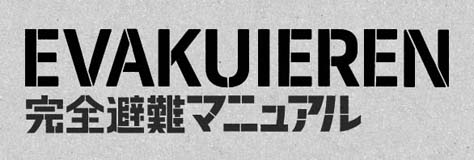Difference between revisions of "Frankfurt evakuieren:About"
| Line 48: | Line 48: | ||
== About Port B == | == About Port B == | ||
<p class="about_portb"> | <p class="about_portb"> | ||
| − | '''Port B''' | + | '''Das Künstlerkollektiv Port B''' wurde 2002 in Tokyo von Akira Takayama gegründet, seine Zusammensetzung ändert sich entsprechend der spezifischen Form des aktuellen Projektes. Port B entwickelt verschiedene künstlerische Aktivitäten wie Installationen im Stadtraum, Tour-Performances, experimentelle Sozialprojekte, Lecture Performances und Besichtigungstouren. Der Ausgangspunkt jedes Projekts ist die Frage „Was ist Theater?“. Port B erweitert darüber die Möglichkeiten des Theaters und sucht heutige Formen, die das Theater mit der Gesellschaft neu verbinden. |
</p><br/> | </p><br/> | ||
<p class="about_portb"> | <p class="about_portb"> | ||
| − | '''Port B''' | + | '''Port B''' was founded in 2002 in Tokyo, by Akira Takayama. It is an artist collective which changes its composition depending on the specific form of the current project. Port B develops different artistic activities like installations in the urban space, tour-performances, experimental social projects, lecture performance and sight-seeing tours. The starting point for each project is: “What is theater?” It thereby expands the possibilities of theater and search new ways in which the theater can connect with society. |
</p> | </p> | ||
<html> | <html> | ||
| Line 72: | Line 72: | ||
</p> | </p> | ||
<div class="artist_text"> | <div class="artist_text"> | ||
| − | Geboren | + | Geboren 1969, gründete 2002 das Künstlerkollektiv Port B. Akira Takayama entwickelt Projekte, die den gängigen Theaterrahmen überschreiten. Ausgehend von theoretischen Überlegungen über die Erfahrung des Zuschauers und in der Rückbesinnung auf die ursprüngliche Bedeutung von „theatron“ als Zuschauerraum, versucht Takayama die „Architektur des Theaters“ zu erweitern und als neue Plattform in der Gesellschaft zu etablieren, die er „Theater 2.0“ nennt. 2011 gründete er den Think-Tank „Port Tourism Research Center“ und entwickelt Projekte in den Bereichen Architektur, Tourismus und Stadtplanung. Takayama sucht nach Bereichen in der Gesellschaft, um deren Möglichkeiten mit Hilfe seines theatralischen Denkens zu erweitern und um neue Konstellationen zu bereichern. |
<br><br> | <br><br> | ||
| − | Born in 1969, founded the | + | Born in 1969, founded in 2002 the artist collective Port B. Akira Takayama develops projects, which go beyond the framework of the existing theater. He tries to expand the “architecture of theater” and establish it as a new platform in society, which he calls “theater 2.0”. He does so, based on theoretical considerations about the experience of the audience and by referring to the original meaning of “theatron” as an auditorium. In 2011 he founded the Think Tank “Port Tourism Research Center” and develops projects in the fields of architecture, tourism and urban planning. Takayama searches areas in society, to expand their possibilities and to enrich new constellations with help of his theatrical thinking. |
<br> | <br> | ||
<div class="tour-b"> | <div class="tour-b"> | ||
Revision as of 19:22, 17 September 2014
Contents
- 1 Was ist EVAKUIEREN?
- 2 Sponsors & Partners
- 3 About Port B
- 4 About Akira Takayama
- 5 Artists
- 5.1 Nuno Ramos
- 5.2 Mariano Pensotti
- 5.3 LIGNA
- 5.4 Quast & Knoblich
- 5.5 Anton Berman
- 5.6 Kondek / Kühl / Weddig
- 5.7 Carlos Motta with Camilo Godoy
- 5.8 OPOVOEMPÉ
- 5.9 Calori & Maillard
- 5.10 Fluchtpunkt (Juliane Kutter & Maria Thrän)
- 5.11 Forschungsgruppe Urban Health Games TU Darmstadt
- 5.12 Lukas Sünder & Sitha Reis
- 5.13 Maki Ishii
- 5.14 Marcus Morgenstern
- 5.15 Matthias Mohr & Oguz Sen
- 6 Staff Credit
Was ist EVAKUIEREN?
EVAKUIEREN ist ein Projekt des japanischen Künstlerkollektivs Port B und des Künstlerhaus Mousonturm Frankfurt. Unter künstlerischer Leitung von Akira Takayama entwickelten 30 internationale Künstlerinnen und Künstler einen ersten Flucht- und Rettungsplan für das Rhein-Main-Gebiet. Als Vorbild diente „The Complete Manual of Evacuation Tokyo“, ein Projekt, das Akira Takayama und Port B 2010 im Rahmen des Festival/Tokyo realisierten.
„Was bedeutet EVAKUIEREN für dich?“ – Auf diese Frage gibt es heute sehr unterschiedliche Antworten. Evakuieren aus einem Katastrophengebiet, Evakuieren aus den Alltagsroutinen, Evakuieren aus den festgefahrenen Selbstbildern. Das Projekt von Port B und Akira Takayama lädt ein, auf vier Touren sehr unterschiedliche „Evakuierungserfahrungen“ zu machen und den Alltag aus einem anderen Blickwinkel zu entdecken. Karten, die über die Webseite heruntergeladen werden können, führen zu 40 „Evakuierungspunkten“ in der gesamten Rhein-Main-Region: Aktionen, Inszenierungen, verborgene Orte, Versammlungen und Spurensuchen. Es bleibt den Teilnehmenden überlassen, welchen Wegen und Umwegen sie folgen, welche neuen Pfade sie einschlagen, um sich von den Begegnungen und Erfahrungen überraschen zu lassen.
EVAKUIEREN ist eine theatralische Architektur.
Wenn das Theater eine Reaktion auf die Zeit und Gesellschaft ist, ist heute der reichste theatralische Stoff die Stadt. Ausgehend von dieser Hypothese greifen theatralische Ideen aktiv in den Stadtraum ein und erweitern die Funktion des Theaters. Theater kann nicht nur als Repräsentation, sondern auch als Werkzeug funktionieren, das verschiedene Medien und Bereiche miteinander verbindet und neue Aufgaben in der Gesellschaft übernimmt. EVAKUIEREN entwickelt eine Praxis zu diesen Fragestellungen und wurde als experimentelle Plattform entworfen.
EVAKUIEREN ist ein System, in dem sich Fremde begegnen.
Wie können wir in dieser kontrollierten Stadt bestehende Programme hacken und eine unkontrollierte Zeit erleben? Es geht um die Flucht aus Schicksal und Identität, beides scheinbar unerbittlich bestimmt von unserem Körper, unserer Herkunft. Gemeinschaften grenzen sich ab, voneinander und von der Stadt, in der sie leben. In EVAKUIEREN geht es um Begegnungen mit Anderen, mit einer anderen Realität, einem anderen „Wir“.
Im EVAKUIEREN sind alle Teilnehmer „Evakuierende“.
Teilnehmer laden selbst Pläne und Karten herunter, lernen sie zu entziffern und zu lesen und entwickeln ihre eigenen Touren. Auf diese Weise erfahren sie im realen Stadtraum verschiedene Evakuierungen. Zwischen einzelnen, sonst nur lose verbundenen Orten entstehen so neue Bezüge, ein theatralischer Layer, der Zusammenhalt stiftet. Indem sich die Teilnehmer den „Evakuierungsgestus“ aneignen, werden sie zugleich Performer und Zuschauer eines Tour-Theaters, das sie selber aufführen.
http://blog.evakuieren.de/
Twitter / Facebook hashtag #EVAKUIEREN
EVACUATION is a project of the Japanese artist collective Port B and the Künstlerhaus Mousonturm. Under the artistic direction of Akira Takayama, 30 international artists developed the first escape and rescue plan for the Rhine-Main Region. “The Complete Manual of Evacuation Tokyo“, a project created by Akira Takayama and Port B in 2010 as part of the Festival/Tokyo, served as a model for EVACUATION.
“What does EVACUATION mean to you?” – Today there are many different answers to this question. Evacuation from a natural disaster, evacuation from daily routines, evacuation from your fixed self-image. In the course of four tours, the project of Port B and Akira Takayama allows participants to have very different “evacuation experiences” and discover daily life from another point of view. Maps that can be downloaded from the website lead to 40 different “evacuation points” in the whole Rhine-Main Region: actions, productions, hidden places, encounters and treasure hunts. It is left to the participants which ways and detours they follow, which new paths they take – so that the encounters and experiences they make are a surprise.
EVACUATION is a theatrical architecture.
If theater is a reaction to the times and society, then the richest theatrical material today is the city. Based on this hypothesis, theatrical ideas actively intervene in the urban space and expand the function of theater. Theater cannot only have a representational function, but should also be a tool that links different mediums and fields and take on new tasks in society. EVACUATION was designed as an experimental platform and puts these themes into question practically.
EVACUATION is a system, in which strangers encounter.
How can we hack existing programs and experience an uncontrolled time setting in this controlled city? The aim is the escape from fate and identity, seemingly inexorably determined by body and origin. Communities differentiate themselves from each other and from the city in which they live. EVACUATION is about encounters with others, with another reality, with another “We”.
In EVACUATION, all participants are „evacuees“.
Participants download maps themselves, learn to decipher and read them and put together their own tours. This way, they discover different “evacuations” in the real urban space. Between single, otherwise only loosely connected places, new references arise – a theatrical layer – which establishes cohesion. By appropriating the “evacuation attitude”, they become performers and spectators at the same time of a tour-theater, which they themselves enact.
http://blog.evakuieren.de/
Twitter / Facebook hashtag #EVAKUIEREN
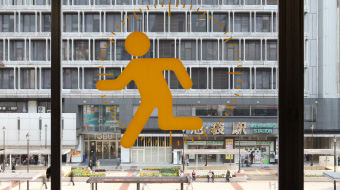
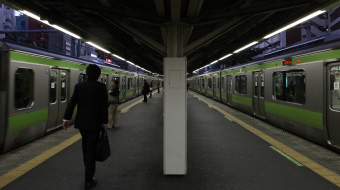
Sponsors & Partners
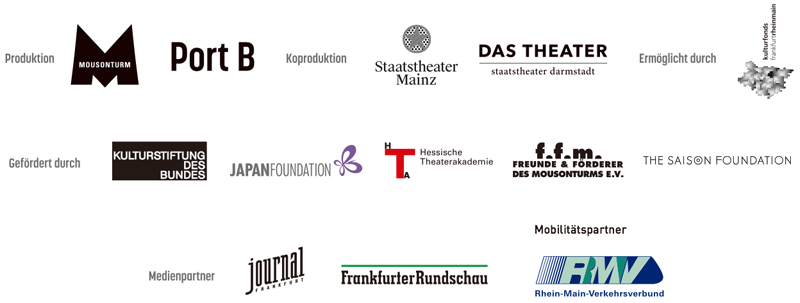
About Port B
Das Künstlerkollektiv Port B wurde 2002 in Tokyo von Akira Takayama gegründet, seine Zusammensetzung ändert sich entsprechend der spezifischen Form des aktuellen Projektes. Port B entwickelt verschiedene künstlerische Aktivitäten wie Installationen im Stadtraum, Tour-Performances, experimentelle Sozialprojekte, Lecture Performances und Besichtigungstouren. Der Ausgangspunkt jedes Projekts ist die Frage „Was ist Theater?“. Port B erweitert darüber die Möglichkeiten des Theaters und sucht heutige Formen, die das Theater mit der Gesellschaft neu verbinden.
Port B was founded in 2002 in Tokyo, by Akira Takayama. It is an artist collective which changes its composition depending on the specific form of the current project. Port B develops different artistic activities like installations in the urban space, tour-performances, experimental social projects, lecture performance and sight-seeing tours. The starting point for each project is: “What is theater?” It thereby expands the possibilities of theater and search new ways in which the theater can connect with society.
http://portb.net/
 portb.official
portb.official
 @Port_B
@Port_B
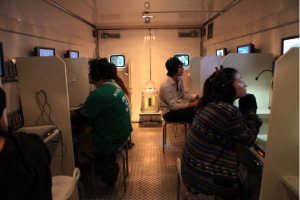
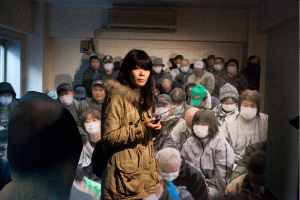
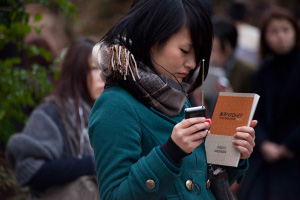
About Akira Takayama

Geboren 1969, gründete 2002 das Künstlerkollektiv Port B. Akira Takayama entwickelt Projekte, die den gängigen Theaterrahmen überschreiten. Ausgehend von theoretischen Überlegungen über die Erfahrung des Zuschauers und in der Rückbesinnung auf die ursprüngliche Bedeutung von „theatron“ als Zuschauerraum, versucht Takayama die „Architektur des Theaters“ zu erweitern und als neue Plattform in der Gesellschaft zu etablieren, die er „Theater 2.0“ nennt. 2011 gründete er den Think-Tank „Port Tourism Research Center“ und entwickelt Projekte in den Bereichen Architektur, Tourismus und Stadtplanung. Takayama sucht nach Bereichen in der Gesellschaft, um deren Möglichkeiten mit Hilfe seines theatralischen Denkens zu erweitern und um neue Konstellationen zu bereichern.
Born in 1969, founded in 2002 the artist collective Port B. Akira Takayama develops projects, which go beyond the framework of the existing theater. He tries to expand the “architecture of theater” and establish it as a new platform in society, which he calls “theater 2.0”. He does so, based on theoretical considerations about the experience of the audience and by referring to the original meaning of “theatron” as an auditorium. In 2011 he founded the Think Tank “Port Tourism Research Center” and develops projects in the fields of architecture, tourism and urban planning. Takayama searches areas in society, to expand their possibilities and to enrich new constellations with help of his theatrical thinking.
und andere Evakuierungspunkte | and other evacuation points
Artists
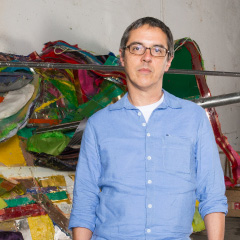
Nuno Ramos
Nuno Ramos (geboren 1960, São Paulo) hat Philosophie an der Universidade de São Paulo studiert und ist als Maler, Zeichner, Bildhauer, Schriftsteller, Filmemacher, Bühnenbildner und Musiktexteschreiber tätig. Als Vertreter Brasiliens hat er 1995 an der Biennale von Venedig, sowie an den Biennalen in São Paulo (1985, 1989, 1994 und 2010) teilgenommen und erhielt 2006 für sein Gesamtwerk von der amerikanischen Barnett and Annalee Newman-Stiftung den Grant Award. Er ist ebenso als Schriftsteller tätig. Für Ó (2008) erhielt er den Preis Portugal Telecom de Literatura.
Nuno Ramos (born in 1960 in São Paulo) studied Philosophy at the Universidade de São Paulo and works today as a painter, drawer, sculptor, author, film maker, set designer and songwriter. He represented Brazil in 1995 at the Venice Biennale, and took part in the São Paulo Biennale in 1985, 1989, 1994 as well as in 2010. In 2006, he received the Grant Award from the American foundation Barnett and Annalee Newman for his complete works. He was also awarded the Portugal Telecom Literature Prize for “Ó”, a book he wrote in 2008.
Mariano Pensotti
Der argentinische Autor und Regisseur Mariano Pensotti (geboren 1973, lebt in Buenos Aires) arbeitete im Bereich Video und Film bevor er sich dem Theater zuwandte. 2010 entstand die Arbeit „Sometimes I think, I can see you“, die das öffentliche Leben einer zeitgenössischen Großstadt poetisch reflektiert.
The Argentinian author and theater director Mariano Pensotti (born in 1973 and living in Buenos Aires) worked in the field of video and film before he turned to theater. In 2010, he created the piece “Sometimes I think, I can see you”, which poetically reflects public life in a contemporary metropolis.
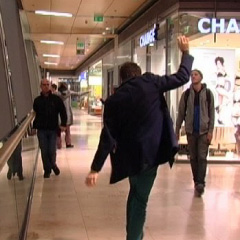
LIGNA
1997 gründete sich die Gruppe LIGNA um die Medientheoretiker, Radio-, Theater- und Performancekünstler Ole Frahm, Michael Hüners und Torsten Michaelsen, die seitdem mit dem Medium Radio im zunehmend kontrollierten öffentlichen Raum experimentieren, oft in Form des von ihnen entwickelten Radioballetts. Die Arbeiten von LIGNA wurden mit internationalen Preisen ausgezeichnet und sind bei Festivals weltweit zu erleben.
In 1997, the media theorists, radio-, theater- and performance artists Ole Frahm, Michael Hüner and Torsten Michaelson formed the group LIGNA. Since then, they have experimented with the medium of radio in the increasingly controlled public space, from which they created their “Radioballet”. The works of LIGNA have been awarded with international prizes and are featured in festivals worldwide.
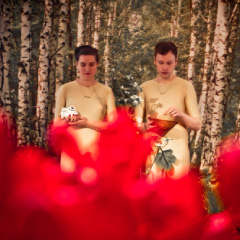
Quast & Knoblich
Hendrik Quast / Maika Knoblich (geboren 1985 / 1986, leben in Berlin) studierten beide u.a. am Institut für Angewandte Theaterwissenschaft in Gießen. Aus ihrem prozessorientierten Arbeitsansatz entwickeln sie in enger Zusammenarbeit mit Experten und regionalen Gemeinschaften vor Ort ihre szenischen, performativen oder installativen Arbeiten. Ihre aufwendigen Projekt-Unikate entwickelten Quast / Knoblich bislang u.a. für das Festival a/d Werf Utrecht, die Sophiensaele in Berlin oder das Künstlerhaus Mousonturm.
Hendrik Quast / Maika Knoblich (born in 1985 / 1986, living in Berlin) both studied, amongst other places at the Institut für Angewandte Theaterwissenschaft in Gießen. From their process-oriented work approach they develop their scenic, performative or installation works in close cooperation with experts and local regional communities. Until now, Quast/Knoblich developed their elaborate unicum projects for the Festival a/d Werf Utrecht, Sophiensaele in Berlin and the Künstlerhaus Mousonturm, and others.
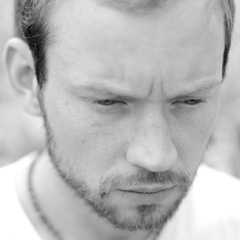
Anton Berman
Anton Berman (geboren 1983 in Moskau, lebt in Deutschland) ist Komponist, Musiker und Sänger. Seit 2000 komponiert er Bühnenmusiken, u.a. für Theater in Bonn, Graz, Hannover, Essen, Aachen, Oldenburg und ab Herbst am Staatstheater Mainz. Anton Berman ist Begründer und Leiter der Internationalen Hochschule für Bikeballet und Balletdesign Istanbul und erhielt 2011 den Ikarus Preis Berlin.
Anton Berman (born in 1983 in Moscow and now living Germany) is a composer, musician and singer. Since 2000, he composes stage music, amongst others, for theaters in Bonn, Graz, Hannover, Essen, Aachen, Oldenburg, and from this autumn onwards at the Staatstheater Mainz. Anton Berman is the founder and director of the International Academy for Bikeballet and Balletdesign Istanbul. In 2011 he was awarded the Ikarus Prize Berlin.

Kondek / Kühl / Weddig
Chris Kondek (geboren 1962 in Boston, lebt in Berlin) / Christiane Kühl (geboren 1966 in Kiel, lebt in Berlin) / Klaus Weddig (geboren 1960 in Clausthal, lebt in Frankfurt). Seit 2004 entwickeln der Videokünstler Kondek und die Journalistin Kühl Theaterarbeiten in lebendiger Auseinandersetzung mit der Finanzwelt. Gemeinsam mit dem Fotografen Weddig dokumentierten sie im Frühjahr im Rahmen des Detroit-Projekts vom Schauspiel Bochum Ciceros "Sieben Strategien gelungenen Überlebens in der geldlosen Gesellschaft" am Ort des Geschehens.
Since 2004, the video artist Chris Kondek (born in 1962 in Boston and living in Berlin), and the journalist Christiane Kühl (born in 1966 in Kiel and living in Berlin), develop theatrical works in a vivid confrontation with the financial world. Together with the photographer Klaus Weddig (born in 1960 in Clausthal and living in Frankfurt and in the frame of the Detroit Project of the Schauspiel Bochum, they documented Cicero’s theses "Sieben Strategien gelungenen Überlebens in der geldlosen Gesellschaft" (Seven Strategies to Successfully Survive in a Moneyless Society) in Bochum.
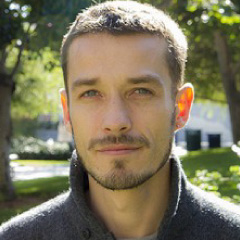
Carlos Motta with Camilo Godoy
Der kolumbianische multidisziplinär arbeitende Künstler Carlos Motta (geboren 1978, lebt in New York) bezieht sich in seinen Arbeiten auf politische Geschichte, um durch Gegenerzählungen ein Bewusstsein für verdrängte Geschichten, Gemeinschaften und queere Identitäten zu schaffen und das Konzept der Demokratie kritisch zu befragen. Mottas Arbeiten wurden vielfach ausgezeichnet und werden weltweit ausgestellt (u.a. Tate Modern London, Museu Serralves Porto, Guggenheim Museum und MoMA New York).
The multidisciplinary Columbian artist Carlos Motta (born in 1978 and now living in New York), refers in his works to political history. By way of counter-narratives, he fosters consciousness for repressed stories, communities and queer identities, as well as critically analyzes the concept of democracy. Motta’s works have received many awards and are exhibited worldwide (among others at the Tate Modern London, Museu Serralves Porto, Guggenheim Museum und MoMA New York).
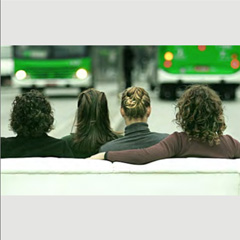
OPOVOEMPÉ
OPOVOEMPÉ wurde durch die künstlerische Leiterin Christiane Zuan Esteves sowie die Performer Ana Luiza Leão, Manuela Afonzo, Graziela Mantoanelli und Paula Possani 2004 in São Paulo begründet. Die Gruppe erarbeitet Performances, Installationen und strategische Interventionen im urbanen Raum, mit denen sie Konventionen und ortsspezifische Eigenheiten auf experimentelle Weise hinterfragen. Dabei konzentriert sich OPOVEMPÉ auf die Möglichkeiten von Bewegung und aktivem Eingreifen in die oft herrschende Apathie und Gleichgültigkeit im öffentlichen Raum und fordert die lebendige Interaktion mit den Zuschauern, um deren Wahrnehmung für die Stadt und die Gesellschaft zu verändern. Das aktuelle Projekt, das im Rahmen von EVAKUIEREN in Frankfurt am Main zu erfahren ist, entstand aus einer Zusammenarbeit der künstlerischen Leiterin Cristiane Zuan Esteves mit Beto Matos, Caio Paduan, Joana Dória und Pedro Semeghini.
OPOVOEMPÉ was founded in 2004 in São Paulo by artistic director Cristiane Zuan Esteves and performers Ana Luiza Leão, Manuela Afonso, Paula Possani and Graziela Mantoanelli. They develop performances, installations and strategic interventions in the urban space, with which they experimentally question conventions and site-specific peculiarities. Thereby, OPOVEMPÉ focuses on the possibilities of movement and active intervention in the often prevailing apathy and indifference in the public space, inviting lively interaction with the audience to change their perception of the city and society. The current project is being created by director Cristiane Zuan Esteves and Opovoempé collaborators Beto Matos, Caio Paduan, Joana Dória and Pedro Semeghini.
Calori & Maillard
Fluchtpunkt (Juliane Kutter & Maria Thrän)
Lukas Sünder & Sitha Reis
Marcus Morgenstern
Staff Credit
Künstlerische Leitung / Artistic Director Akira Takayama
Teilnehmende Künstler / Participating Artists Mariano Pensotti / Carlos Motta & Camilo Godoy / Nuno Ramos / OPOVOEMPÉ (Christiane Zuan Esteves & Roberto Basílio de Matos & Pedro Semeghini & Caio Paduan & Joana Dória) / LIGNA (Torsten Michaelsen & Ole Frahm & Michael Hueners) / Chris Kondek & Christiane Kühl & Klaus Weddig / Hendrik Quast & Maika Knoblich / Anton Berman /
Lukas Sünder & Sitha Reis / Matthias Mohr & Oguz Sen / Lars Werneke / Fluchtpunkt (Juliane Kutter & Maria Thrän) / Marcus Morgenstern / Forschungsgruppe Urban Health Games TU Darmstadt / Calori & Maillard / Maki Ishii
Grafische Gestaltung / Graphic Design Hironori Oooka / Kei Uchida (Hironori Oooka Office)
Programmierung / Web Programming Jiro Motonaga
Kartographie / Map Design Sayuri Fujii
Topographie / Surveying Kohei Fukazawa
Systementwicklung / Project System Engineering Tatsuki Hayashi
Kuratorische Mitarbeit / Location Research Annette Gloser
Dramaturgie / Dramaturgy Chiaki Soma
Künstlerische Mitarbeit / Artistic Collaborator Maki Ishii
Künstlerische Assistenz / Assistant Director Saki Tanaka
Dokumentation / Documentation Photographer Masahiro Hasunuma
Projekt-Koordination / Project Coordination Fumiko Toda
Produktionsleitung / Production Management Inga Wagner / Olivia Ebert
Produktionsassistenz / Production Assistant Teresa Bernauer / Caroline Brendel
Freiwillige Mitarbeiter / Volunteers Kristijan Balta / Annika Böndgen / Timo Cromm / Eva Döhne / Oliver Franke / Milena Kan / Jasmin Klotz / Lisa Kreutzer / Sofie Luckhardt / Anika Marschall / Marvin Otto / Katharina Polley / Jessica Pulver / Lisa Richter / Shun Takeishi / Marie Schaarschmidt / Katja Schaffer / Alexej Ulinici / Dennis Vetter / Antje Zöchling
Künstlerhaus Mousonturm
Intendant und Geschäftsführer / Artistic and Managing Director Matthias Pees
Verwaltung / Administration Martina Leitner / Bernd Steuernagel / Katja Liebetruth / Justin Kreutz
Dramaturgie / Dramaturgy Marcus Droß / Anna Wagner / Elisa Liepsch / Anja Sauer
Produktionsteam / Production management Carsten Schrauff / Dea Lapi
Presse- und Öffentlichkeitsarbeit / Communication office Gabriele Müller / Elke Lötterle / Julia Kretschmer / Thekla Stobbe / Lars Sellien
Technik / Technical team Michael Schlund / Stefan Matheke / Joachim Schött / Michael Lauth / Norbert Mohr
Werkstatt Arnold Frühwald
Haustechnik Walter Lottré / Ralph Hintzen
Betriebsbüro Dorothé Gebhart / Beate Korell / Matthias Heng
Kasse und Information Karola Iserath
Produktion / Production Port B / Künstlerhaus Mousonturm Frankfurt am Main GmbH
Koproduktion / Co-Production Staatstheater Darmstadt / Staatstheater Mainz
Gefördert von / Funded by Kulturstiftung des Bundes (German Federal Culture Foundation)
Ermöglicht durch / Enabled by Kulturfonds Frankfurt RheinMain
Weitere Förderer / Additional support Japan Foundation / Hessische Theaterakademie / Rhein-Main-Verkehrsverbund / Freunde & Förderer des Mousonturms e.V. / Saison Foundation
